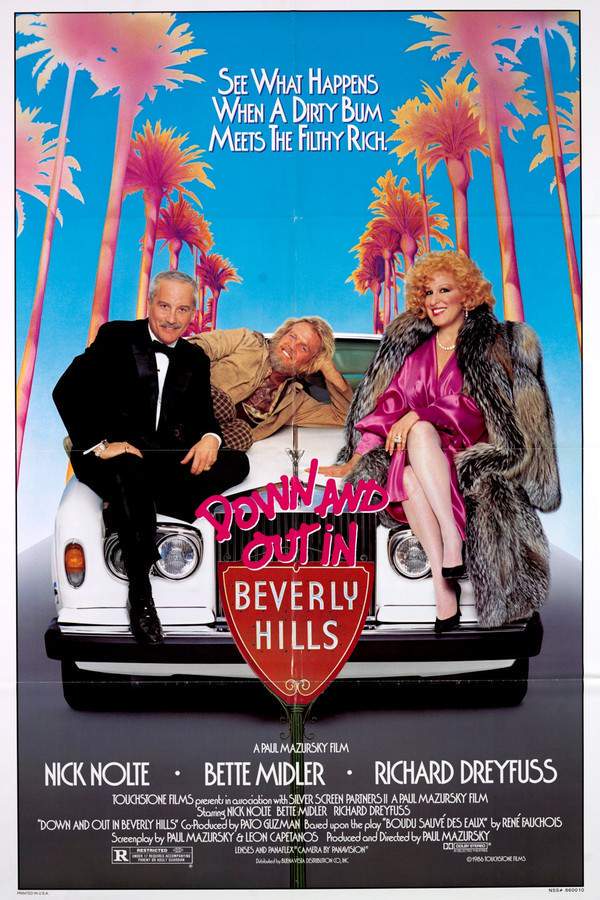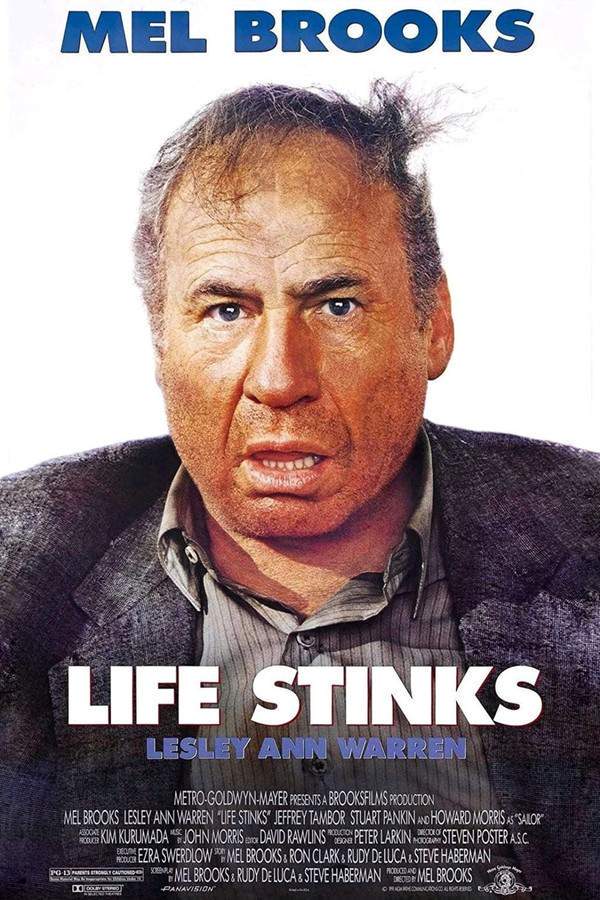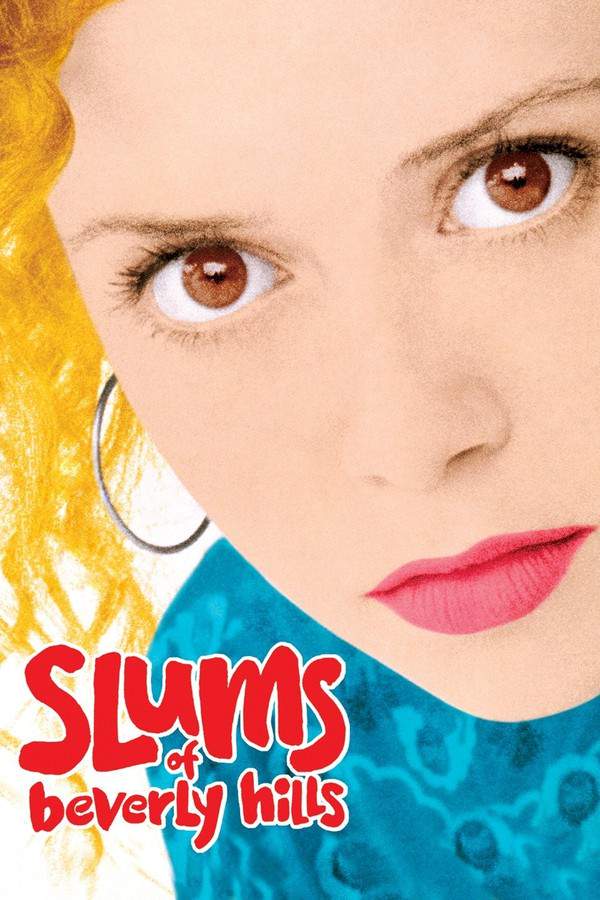
Down and Out in Beverly Hills 1986
Directed by

Paul Mazursky
Made by

Buena Vista Pictures
Test your knowledge of Down and Out in Beverly Hills with our quiz!
Down and Out in Beverly Hills Plot Summary
Read the complete plot summary and ending explained for Down and Out in Beverly Hills (1986). From turning points to emotional moments, uncover what really happened and why it matters.
In the affluent enclave of Beverly Hills, a pervasive sense of stagnation envelops the Whiteman family like a heavy shroud. The once-vibrant marriage between Dave, the dynamic entrepreneur behind a wire garment hanger company called Dave-Bar, and his wife Barbara has sadly devolved into mere coexistence—with their two decades together reduced to a monotonous routine of impersonal exchanges. This unraveling of their relationship is exacerbated by Dave’s passionate affair with Carmen, their live-in maid, as Barbara seeks solace from her escalating discontent through a mix of New Age therapies and compulsive shopping habits.
Meanwhile, their teenage son Max grapples with a profound disconnect from his parents, opting instead to convey his feelings through avant-garde video art that serves as both an exploration of his own identity crisis and a critique of his family’s superficial lifestyle. The Whitemans’ daughter Jenny, a 19-year-old navigating her own turbulent journey, faces increasing friction with her father, who suspects her struggles with self-image and poor decisions stem from an eating disorder. Additionally, their pet dog Matisse reflects the household’s dysfunction through his troubling behaviors, further showcasing the family’s struggles.
Amidst this chaos enters Jerry Baskin, a homeless man who is mourning his lost companion. In a desperate moment by the Whitemans’ pool, as he attempts to end his life, Dave intervenes, saving him and offering temporary refuge in their home. This unexpected encounter leads to an unlikely friendship as Jerry shares stories about his past fortune and success, starkly juxtaposing Dave’s prevailing materialistic values.
As Jerry becomes a part of the Whiteman household, his presence begins to work wonders. He ignites Barbara’s long-dormant passions, leading to a profound connection between them. However, this rekindled intimacy introduces tensions with both Carmen and Dave, as Jerry’s closeness pushes against the family’s existing dynamics. Furthermore, Max finds himself opening up about his gender identity, encouraged by Jerry’s understanding demeanor.
The tension climaxes during a lavish party thrown by the Whitemans. In a shocking revelation, Jenny expresses her newfound feelings for her father and underscores her recovery from anorexia, provoking a physical clash between Dave and Jerry. This chaotic confrontation escalates, involving partygoers and ends with all three men floundering helplessly in the swimming pool.
As dawn breaks on the following day, Jerry faces the ramifications of his stretched truths. He acknowledges the fictional nature of the tales he recounted about his former life, steadfastly preparing himself to leave the Whiteman estate. Now accompanied by Matisse, Jerry slowly walks down the service alleyway, his steps resonating in the silence as he takes a last look at the household staff, whose expressions reflect a blend of yearning and resignation.
In a contemplative moment, Jerry’s gaze meets those of his newfound friends, their collective stare imbued with poignant farewell. The atmosphere is dense with unexpressed feelings as Jerry’s face softens in the realization of their shared bond, prompting him to rejoin the group. Together, they make their way back into the estate grounds, a space that now feels steeped in an aura of warmth and connection.
Down and Out in Beverly Hills Timeline
Follow the complete movie timeline of Down and Out in Beverly Hills (1986) with every major event in chronological order. Great for understanding complex plots and story progression.
Stagnation of the Whiteman Family
The Whiteman family, living in Beverly Hills, is engulfed in a sense of stagnation. Their life is marked by impersonal exchanges and a monotonous routine that has drained the vibrancy from their marriage.
Dave's Affair with Carmen
Dave, the entrepreneur of Dave-Bar, engages in a passionate affair with their live-in maid, Carmen. This indiscretion adds further strain to his already faltering marriage with Barbara.
Barbara's Struggles
As dissatisfaction mounts, Barbara seeks solace through New Age therapies and comfort shopping. This behavior highlights her emotional turmoil and desire for change amid a spiraling relationship with Dave.
Max's Identity Crisis
The teenage son, Max, deals with feelings of alienation from his parents, using avant-garde video art to express his identity crisis. His work serves as both a reflection and critique of his family's superficial lifestyle.
Jenny's Turmoil with Self-Image
Nineteen-year-old Jenny struggles with self-image issues, leading her to conflict with her father. She battles what seems to be an eating disorder, which adds to her father's worries about her well-being.
Jerry's Desperate Attempt
Jerry Baskin, a homeless man mourning his lost companion, attempts to end his life by the Whitemans' pool. Dave intervenes, saving Jerry and offering him refuge in their home, setting off a chain of unexpected events.
Unlikely Friendship Forms
After moving into the Whiteman household, Jerry begins to develop a friendship with Dave. Their conversations offer contrasting perspectives on life, exposing the materialism that dominates Dave's existence.
Barbara Rekindles Her Passion
Jerry's presence reignites a sense of passion in Barbara that had long been dormant. This newfound connection leads to tensions as both she and Dave navigate shifting dynamics in their relationship.
Max Opens Up
Encouraged by Jerry's understanding nature, Max begins to explore and express his gender identity. This vital moment marks a significant step forward in his journey towards self-acceptance.
The Lavish Party
During a lavish party hosted by the Whitemans, tensions reach a boiling point. Jenny makes a shocking revelation about her feelings for her father, leading to a physical confrontation between Dave and Jerry.
Climactic Confrontation
The confrontation escalates quickly, involving the partygoers as emotions run high. The chaos culminates in all three men ending up in the swimming pool, showcasing the turmoil within the family.
Jerry's Remorse
The next morning, Jerry reflects on the fictional tales he told about his past. Preparing to leave, he feels the emotional weight of his relationships with the Whitemans, acknowledging the truths he stretched.
Final Farewell
As Jerry walks down the service alleyway with Matisse, he takes a final look at the household staff, who watch with mixed emotions. This poignant farewell signals the end of his brief but impactful time with the family.
Reunion of Bonds
In a moment of contemplation, Jerry's gaze meets those of the Whitemans, capturing their shared bond. Realizing the depth of their connection, he chooses to rejoin the group, filled with warmth and new understanding.
A New Beginning
Together, Jerry and the Whitemans move back into the estate grounds. This moment marks a sort of new beginning for the family, now imbued with an aura of warmth and connection that was previously absent.
Down and Out in Beverly Hills Characters
Explore all characters from Down and Out in Beverly Hills (1986). Get detailed profiles with their roles, arcs, and key relationships explained.
Dave Whiteman
Dave is the patriarch of the Whiteman family, an entrepreneur struggling with marital discord and an affair. He embodies the materialistic values of Beverly Hills, yet his interactions with Jerry challenge him to reassess his priorities and relationships.
Barbara Whiteman
Barbara is Dave's wife, caught in a cycle of discontent and seeking fulfillment through New Age therapies. Her character evolves as she rekindles her passions through her bond with Jerry, revealing a depth beyond her initial struggles.
Jerry Baskin
Jerry is a homeless man whose arrival disrupts the Whiteman family's superficial existence. His past success and genuine demeanor inspire change in the family members, especially Barbara and Max, as they confront their identities and relationships.
Max Whiteman
Max, the teenage son, stands apart from his family's distractions, using video art to seek understanding of himself and his relationship with his parents. His personal struggles with identity become more apparent through his interactions with Jerry.
Jenny Whiteman
Jenny, the Whiteman's daughter, struggles with self-image amidst family pressures, eventually confronting her eating disorder. Her character arc speaks to the impact of parental relationships on self-acceptance and recovery.
Matisse
Matisse, the family dog, embodies the dysfunction of the Whiteman household through his behavior. His presence adds a layer of mirroring to the family's struggles and ultimately joins Jerry as he leaves in search of peace.
Down and Out in Beverly Hills Settings
Learn where and when Down and Out in Beverly Hills (1986) takes place. Explore the film’s settings, era, and how they shape the narrative.
Time period
The events of the movie unfold in a contemporary setting, reflective of the 1980s culture in America, characterized by a growing obsession with materialism and personal identity crises. This period also saw a rise in New Age philosophies, which Barbara engages with as she seeks fulfillment amidst her discontent.
Location
Beverly Hills
Beverly Hills is an affluent enclave located in Los Angeles County, known for its luxurious homes and celebrity inhabitants. It epitomizes wealth and glamour, offering a stark contrast to the struggles of those within its opulent walls, particularly highlighted by the Whiteman family's emotional turmoil.
Down and Out in Beverly Hills Themes
Discover the main themes in Down and Out in Beverly Hills (1986). Analyze the deeper meanings, emotional layers, and social commentary behind the film.
🤝
Connection
The theme of connection is central to the narrative, highlighting the importance of relationships in overcoming personal struggles. Jerry's unexpected bond with the Whiteman family fosters a sense of belonging and prompts personal growth among the characters. As they navigate their own challenges, the shared experiences create an environment of support and transformation.
🌀
Identity
Identity is a prominent theme, explored through the characters' struggles with self-perception and societal expectations. Max's artistic expression and Jenny's confrontation with her eating disorder reveal the complexities of understanding oneself in a world that often prioritizes superficiality. Their journeys are illuminated by Jerry's contrasting life experiences, challenging the family's values.
🚪
Change
Change permeates the plot, from the Whiteman family's stagnant relationships to the transformative influence of Jerry. His arrival disrupts their routine and forces them to confront their issues, leading to personal revelations and a shift in dynamics among family members. As they adapt to these changes, the characters learn the value of honesty and vulnerability.

Coming soon on iOS and Android
The Plot Explained Mobile App
From blockbusters to hidden gems — dive into movie stories anytime, anywhere. Save your favorites, discover plots faster, and never miss a twist again.
Sign up to be the first to know when we launch. Your email stays private — always.
Down and Out in Beverly Hills Spoiler-Free Summary
Discover the spoiler-free summary of Down and Out in Beverly Hills (1986). Get a concise overview without any spoilers.
In the sun‑drenched enclave of Beverly Hills, a sprawling mansion houses the Whiteman family, whose polished exterior masks a quiet sense of stagnation. Dave runs a successful wire‑hanger company, yet his marriage to Barbara has settled into a polite, almost mechanical routine. Their lives are surrounded by a steady hum of luxury—designer wardrobes, polished décor, and the ever‑present undercurrent of unspoken dissatisfaction. Adding texture to the household are Carmen, the live‑in maid whose flirtations blur the line between service and intimacy, and their teenage children: Max, an artistic soul who expresses himself through avant‑garde video, and Jenny, a young woman navigating the pressures of appearance and independence, all while the family’s spoiled golden retriever, Matisse, wags his tail through the same corridors of excess.
A chance encounter at the pool introduces Jerry—a homeless man on the brink of ending his own story. Rescued by Dave, he steps into the opulent world he has long observed only from a distance. Jerry carries with him the remnants of a past life of wealth, his sharp wit and sardonic observations offering a mirror to the Beverly Hills glitter that often feels hollow. His sudden presence is both a jolt and a curiosity, as he moves through rooms dripping with designer polish, noting the absurdities of a world where status outweighs sincerity.
The film settles into a tone that balances biting satire with heartfelt comedy, letting Jerry’s outsider perspective highlight the quirks and contradictions of the Whiteman household. As he interacts with Barbara, Carmen, and the restless teenagers, his unvarnished honesty begins to stir dormant emotions, prompting both laughter and uneasy reflection. The story promises a playful dance between wealth and vulnerability, inviting the audience to wonder whether a man without a home can, perhaps inadvertently, teach a family whose fortunes are secure but whose hearts are adrift how to feel again.
Can’t find your movie? Request a summary here.
Movies with Similar Twists and Themes
Uncover films that echo the narrative beats, emotional arcs, or dramatic twists of the one you're exploring. These recommendations are handpicked based on story depth, thematic resonance, and spoiler-worthy moments — perfect for fans who crave more of the same intrigue.
Featured on this page

What's After the Movie?
Not sure whether to stay after the credits? Find out!
Explore Our Movie Platform
New Movie Releases (2025)
Famous Movie Actors
Top Film Production Studios
Movie Plot Summaries & Endings
Major Movie Awards & Winners
Best Concert Films & Music Documentaries
Movie Collections and Curated Lists
© 2025 What's After the Movie. All rights reserved.














